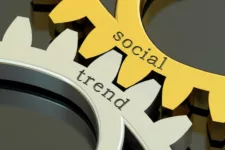To most people, trends are an utter and complete mystery. Where did skinny jeans come from, and why have they lasted so long? Why is electronic dance music so hip right now when it was so niche just a decade ago? How can some pets find fame through meme-hood while others seem like just regular, boring cats and dogs? Old trends disappear, new ones emerge, and nearly everyone is chained to this eternal cycle — even businesses.
Businesses stand to gain significantly by paying attention to social trends. By utilizing trends for marketing purposes, businesses can better engage with their audiences and more effectively convert sales. Even better than merely being attentive, businesses might be able to predict upcoming trends by better understanding the science behind them.
Whether fashion, music, memes, or something more, trends impact businesses and consumers alike. Here’s a brief explanation of how trends develop — and how to foresee the next big trend.

How Trends Happen
In truth, trends have always been integral to the human experience. Researchers believe that a primary reason homo sapiens has risen to the top of the food chain was the unending cycle of innovation and emulation that encouraged our ancestors to develop better tools for finding food, building shelter, and protecting their families. Today, trends can seem meaningless, but many actually have large-scale ramifications on the social, political, and economic environment. For example, the doge meme, which features an innocent-looking Shiba Inu overlaid with ungrammatical “dog-speak,” has sparked a movement of doge-related merchandise as well as a rapidly accelerating cryptocurrency that could compete with Bitcoin. Seeing as though cryptocurrencies are disrupting markets and threatening to replace traditional currencies everywhere, simple doge could be a world-changing trend.
Then and now, trends develop through a regular process. First, an innovator produces something different or better. Innovators compose 2.5 percent of the population, and typically they are social outcasts or self-imposed hermits oblivious or uninterested in mainstream habits. For example, James Dyson rejected the idea that vacuums were as good as they could get and created more than 5,000 prototypes before making it big with the Dyson model.
The line between success and failure in innovation is razor thin, and millions of innovators are never truly recognized for their work. That is why innovators are hardly the most important actors in the development of trends; rather, early adopters can claim that honor. Unlike innovators, early adopters look like the quintessential trendsetters: They have large social media followings, they curate their image carefully, and they identify as cultured and urbane.
From the early adopters, and early majority catches onto emerging trends. At this point, a trend is likely to begin appearing in magazines and on streets, but the early adopters have likely moved onto something new. The early majority enjoys new trends because of the perceived exclusivity and uniqueness of them; hipsters are a prime example of the early majority, which composes 34 percent of the population. Slowly, the late majority begins to accept the trend. Unlike the other groups, the late majority is more insecure and less accepting of change. Thus, they must be constantly reassured of a trend’s popularity before they adopt it. Still, at another whopping 34 percent of the population, the late majority is a massive consumer force that businesses must be willing to woo.
Ultimately, trends are spread from individual to individual; each single consumer is responsible for perpetuating and inflating a particular trend, which means businesses must be willing and able to engage with their audience to effectively understand and influence ongoing trends.
Predictions and Predilections
Though the evolution of a trend is easy to plot, experts remain relatively bad at predicting trends before innovators and early adopters get started. Lists of emerging social trends are typically compiled after early adopters have been actively promoting the trend for some time — which isn’t to say that they are untrue, but rather that they are rarely cutting edge. Still, businesses usually fall into the late majority or laggard groups, so they are usually rather desperate for any indications of developing trends.
Businesses can improve in their predictions and use of trends — but it requires a healthy budget and concerted effort. The most trailblazing businesses usually have a diverse team of leaders on the payroll to monitor innovators and early adopters for signs of new trends. Then, they explore new ideas, cluster them into different types, and prioritize those most likely to impact the business. It takes years to develop a method for recognizing and applying trends, but considering how significantly businesses depend on social trends, the process is likely worthwhile.








